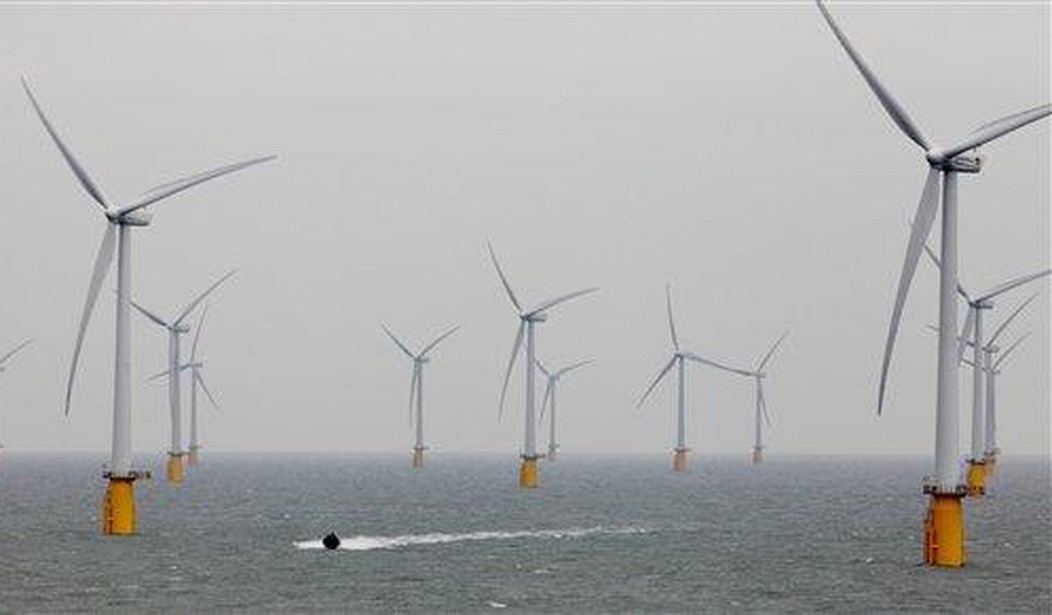A new peer reviewed study from German scientists found that offshore wind farms — the sort of supposedly "green" alternative to existing energy sources with which President Biden and Democrats want to fill America's coastal waters — are not as safe for marine ecosystems as their proponents may argue.
The researchers looked at one area and ecosystem in particular — the North Sea — where the world's largest offshore wind farm (OWF) opened earlier in 2022. Relying on modeling and simulations in order to see what the "systematic, large-scale, time-integrated response of the ocean to large OWF clusters" would be, the study's authors found evidence that offshore wind power generation, supposedly great for the planet actually introduced factors that negatively impact sea life.
According to a summary of the study, researchers reported that their "results provide evidence that the ongoing off shore wind farm developments can have a substantial impact on the structuring of coastal marine ecosystems on basin scales."
Now, for the science, as explained by the study's authors:
The wind wake effect of offshore wind farms affects the hydrodynamical conditions in the ocean, which has been hypothesized to impact marine primary production. So far only little is known about the ecosystem response to wind wakes under the premisses of large off shore wind farm clusters. Here we show, via numerical modeling, that the associated wind wakes in the North Sea provoke large-scale changes in annual primary production with local changes of up to ±10% not only at the offshore wind farm clusters, but also distributed over a wider region. The model also projects an increase in sediment carbon in deeper areas of the southern North Sea due to reduced current velocities, and decreased dissolved oxygen inside an area with already low oxygen concentration.
[...]
In addition to impacts on the regional atmosphere, multiple physical, biological, and chemical impacts on the marine system have been identified. The under-water structures, such as foundations and piles may cause turbulent current wakes, which impact circulation, stratification, mixing, and sediment resuspension. Most studies conclude that the direct hydrodynamic consequences of the wind farm structures are mainly restricted to the area within the wind farms. However, some speculate also, that the cumulative impacts of an increasing number of offshore installations might result in substantial impacts on the larger scale stratification. Larger scale effects of offshore wind energy production, well beyond the wind farm areas, are introduced to the atmosphere by infrastructures above the sea level and the energy extraction itself. Atmospheric wakes appearing in the lee of wind farms extend on scales up to 65 km and beyond, depending on atmospheric stability, with a wind speed reduction of up to 43% inside the wakes leading to upwelling and downwelling dipoles in the ocean beneath.
Recommended
Those impacts, according to simulations focused on North Sea projects run by the researchers, led them to their conclusion based on evidence showing "that the increasing amount of future OWF installations will substantially impact and restructure the marine ecosystem of the southern and central North Sea."
As examples, the study cited the "diversity of marine fauna" in the southern North Sea, including "economically relevant fish stocks" which could see offshore wind farms "impact the survival of fish early life stages in specific areas" due to "variations in the match-mismatch dynamics with their pray or as a consequence of low oxygen conditions." The study also notes that "estimated changes in organic sediment distribution and quantity could have an effect on the habitat quality for benthic species such as lesser sandeel and other benthic species that live in the sediments in the deeper areas of the southern North Sea."
While there's significantly more research yet to be done on the impact of offshore (and onshore) wind farms on the ecosystems where they're constructed, proponents of the alternative and supposedly "green" power generation method act as though there are no ill effects caused by wind farms.
What's more, President Biden and his anti-energy independence administration have made offshore wind farms a priority of their radical "green" agenda. Earlier this year, the White House announced its goal of creating 30 gigawatts of offshore wind generation capacity by 2030. The "clean energy" they claim is provided by offshore wind, however, according to the study quoted above, might actually not be so clean and could — if the same impacts noted in the North Sea apply to U.S. coastal waters — harm the ecosystems Biden claims his "green" energy will save.

























Join the conversation as a VIP Member